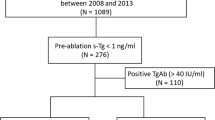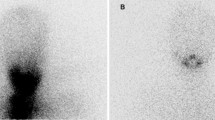Abstract
Purpose
Based on a single older study it is established dogma that TSH levels should be ≥30 mU/l at the time of postoperative 131I ablation in differentiated thyroid cancer (DTC) patients. We sought to determine whether endogenous TSH levels, i.e. after levothyroxine withdrawal, at the time of ablation influence ablation success rates, recurrence-free survival and DTC-related mortality.
Methods
A total of 1,873 patients without distant metastases referred for postoperative adjuvant 131I therapy were retrospectively included from 1991 onwards. Successful ablation was defined as stimulated Tg <1 μg/l.
Results
Age, gender and the presence of lymph node metastases were independent determinants of TSH levels at the time of ablation. TSH levels were not significantly related to ablation success rates (p = 0.34), recurrence-free survival (p = 0.29) or DTC -elated mortality (p = 0.82), but established risk factors such as T-stage, lymph node metastases and age were. Ablation was successful in 230 of 275 patients (83.6 %) with TSH <30 mU/l and in 1,359 of 1,598 patients (85.0 %) with TSH ≥30 mU/l. The difference was not significant (p = 0.55). Of the whole group of 1,873 patients, 21 had recurrent disease. There were no significant differences in recurrence rates between patients with TSH <30 mU/l and TSH ≥30 mU/l (p = 0.16). Ten of the 1,873 patients died of DTC. There were no significant differences in DTC-specific survival between patients with TSH <30 mU/l and TSH ≥30 mU/l (p = 0.53).
Conclusion
The precise endogenous TSH levels at the time of 131I ablation are not related to the ablation success rates, recurrence free survival and DTC related mortality. The established dogma that TSH levels need to be ≥30 mU/l at the time of 131I ablation can be discarded.




Similar content being viewed by others
References
Edmonds CJ, Hayes S, Kermode JC, Thompson BD. Measurement of serum TSH and thyroid hormones in the management of treatment of thyroid carcinoma with radioiodine. Br J Radiol. 1977;50:799–807.
Cooper DS, Doherty GM, Haugen BR, Kloos RT, Lee SL, Mandel SJ, et al. Revised American Thyroid Association management guidelines for patients with thyroid nodules and differentiated thyroid cancer. Thyroid. 2009;19:1167–214.
Luster M, Clarke SE, Dietlein M, Lassmann M, Lind P, Oyen WJ, et al. Guidelines for radioiodine therapy of differentiated thyroid cancer. Eur J Nucl Med Mol Imaging. 2008;35:1941–59.
Pacini F, Schlumberger M, Dralle H, Elisei R, Smit JW, Wiersinga W. European consensus for the management of patients with differentiated thyroid carcinoma of the follicular epithelium. Eur J Endocrinol. 2006;154:787–803.
Pacini F, Castagna MG, Brilli L, Pentheroudakis G. Thyroid cancer: ESMO Clinical Practice Guidelines for diagnosis, treatment and follow-up. Ann Oncol. 2010;21 Suppl 5:v214–9.
Kogai T, Endo T, Saito T, Miyazaki A, Kawaguchi A, Onaya T. Regulation by thyroid-stimulating hormone of sodium/iodide symporter gene expression and protein levels in FRTL-5 cells. Endocrinology. 1997;138:2227–32.
Kogai T, Curcio F, Hyman S, Cornford EM, Brent GA, Hershman JM. Induction of follicle formation in long-term cultured normal human thyroid cells treated with thyrotropin stimulates iodide uptake but not sodium/iodide symporter messenger RNA and protein expression. J Endocrinol. 2000;167:125–35.
Ajjan RA, Kamaruddin NA, Crisp M, Watson PF, Ludgate M, Weetman AP. Regulation and tissue distribution of the human sodium iodide symporter gene. Clin Endocrinol (Oxf). 1998;49:517–23.
Wagner S, Aust G, Schott M, Scherbaum WA, Feldkamp J, Seissler J. Regulation of sodium-iodide-symporter gene expression in human thyrocytes measured by real-time polymerase chain reaction. Exp Clin Endocrinol Diabetes. 2002;110:398–402.
Napoli R, Biondi B, Guardasole V, D'Anna C, De Sena A, Pirozzi C, et al. Enhancement of vascular endothelial function by recombinant human thyrotropin. J Clin Endocrinol Metab. 2008;93:1959–63.
Vrachimis A, Schober O, Riemann B. Radioiodine remnant ablation in differentiated thyroid cancer after combined endogenous and exogenous TSH stimulation. Nuklearmedizin. 2012;51:67–72.
Vrachimis A, Riemann B, Gerss J, Maier T, Schober O. Peace of mind for patients with differentiated thyroid cancer? Nuklearmedizin. 2013;52:115–20.
Vrachimis A, Gerss J, Stoyke M, Wittekind C, Maier T, Wenning C, et al. No significant difference in the prognostic value of the 5th and 7th editions of AJCC staging for differentiated thyroid cancer. Clin Endocrinol (Oxf). 2014;80:911–7.
Rahbar K, Hutzenlaub V, Fischer RJ, Schober O, Riemann B. Risk-profile and outcome of small papillary and follicular thyroid carcinomas (<1 cm). Nuklearmedizin. 2008;47:188–93.
Verburg FA, Mader U, Luster M, Reiners C. Histology does not influence prognosis in differentiated thyroid carcinoma when accounting for age, tumour diameter, invasive growth and metastases. Eur J Endocrinol. 2009;160:619–24.
Verburg FA, Stokkel MP, Duren C, Verkooijen RB, Mader U, van Isselt JW, et al. No survival difference after successful (131)I ablation between patients with initially low-risk and high-risk differentiated thyroid cancer. Eur J Nucl Med Mol Imaging. 2010;37:276–83.
Verburg FA, Mader U, Luster M, Reiners C. Primary tumour diameter as a risk factor for advanced disease features of differentiated thyroid carcinoma. Clin Endocrinol (Oxf). 2009;71:291–7.
Verburg FA, Mader U, Tanase K, Thies ED, Diessl S, Buck AK, et al. Life expectancy is reduced in differentiated thyroid cancer patients ≥ 45 years old with extensive local tumor invasion, lateral lymph node, or distant metastases at diagnosis and normal in all other DTC patients. J Clin Endocrinol Metab. 2013;98:172–80.
Verburg FA, Mader U, Reiners C, Hanscheid H. Long-term survival in differentiated thyroid cancer is worse after low-activity initial post-surgical (131)I therapy in both high- and low-risk patients. J Clin Endocrinol Metab. 2014;99:4487–96.
Tanase K, Thies ED, Mader U, Reiners C, Verburg FA. The TNM system (version 7) is the most accurate staging system for the prediction of loss of life expectancy in differentiated thyroid cancer. Clin Endocrinol (Oxf). 2015. doi:10.1111/cen.12765
Thies ED, Tanase K, Maeder U, Luster M, Buck AK, Hanscheid H, et al. The number of 131I therapy courses needed to achieve complete remission is an indicator of prognosis in patients with differentiated thyroid carcinoma. Eur J Nucl Med Mol Imaging. 2014;41:2281–90.
Maier TM, Schober O, Gerss J, Gorlich D, Wenning C, Schaefers M, et al. Differentiated thyroid cancer patients more than 60 years old paradoxically show an increased life expectancy. J Nucl Med. 2015;56:190–5.
Sobin LH, Gospodarowicz MK, Wittekind C. TNM classification of malignant tumours. 7th ed. New York: Wiley-Blackwell; 2009.
Rendl J, Grelle I, Reiners C. Methodical properties and clinical efficiency of a novel Tg-assay in the follow-up of differentiated thyroid carcinomas. Nuklearmedizin. 1994;33:A13.
Rodriguez-Espinosa J, Mora-Brugues J, Ordonez-Llanos J, Cortes-Rius M, Queralto-Companyo JM, Gonzalez-Sastre F. Technical and clinical performance of six sensitive immunoradiometric assays of thyrotropin in serum. Clin Chem. 1987;33:1439–45.
Pacini F, Ladenson PW, Schlumberger M, Driedger A, Luster M, Kloos RT, et al. Radioiodine ablation of thyroid remnants after preparation with recombinant human thyrotropin in differentiated thyroid carcinoma: results of an international, randomized, controlled study. J Clin Endocrinol Metab. 2006;91:926–32.
Mallick U, Harmer C, Yap B, Wadsley J, Clarke S, Moss L, et al. Ablation with low-dose radioiodine and thyrotropin alfa in thyroid cancer. N Engl J Med. 2012;366:1674–85.
Schlumberger M, Catargi B, Borget I, Deandreis D, Zerdoud S, Bridji B, et al. Strategies of radioiodine ablation in patients with low-risk thyroid cancer. N Engl J Med. 2012;366:1663–73.
Verburg FA, Mader U, Grelle I, Visser TJ, Peeters RP, Smit JW, et al. The thyroid axis 'setpoints' are significantly altered after long-term suppressive LT4 therapy. Horm Metab Res. 2014;46:794–9.
Uribe RM, Zacarias M, Corkidi G, Cisneros M, Charli JL, Joseph-Bravo P. 17beta-Oestradiol indirectly inhibits thyrotrophin-releasing hormone expression in the hypothalamic paraventricular nucleus of female rats and blunts thyroid axis response to cold exposure. J Neuroendocrinol. 2009;21:439–48.
Verburg F, Weber T, Luster M. 131I sodium-iodide versus 56Fe surgical steel. Which is better for lateral lymph node metastases in differentiated thyroid cancer patients? Nuklearmedizin. 2013;52:113–4.
Hanscheid H, Lassmann M, Buck AK, Reiners C, Verburg FA. The limit of detection in scintigraphic imaging with I-131 in patients with differentiated thyroid carcinoma. Phys Med Biol. 2014;59:2353–68.
Diessl S, Verburg F, Biko J, Schryen B, Reiners C, Buck A, et al. Improved follow-up of patients with differentiated thyroid carcinoma. The quantitative detection limit of 131I uptake in diagnostic scans. Nuklearmedizin. 2013;52:81–7.
Haugen BR, Pacini F, Reiners C, Schlumberger M, Ladenson PW, Sherman SI, et al. A comparison of recombinant human thyrotropin and thyroid hormone withdrawal for the detection of thyroid remnant or cancer. J Clin Endocrinol Metab. 1999;84:3877–85.
Pacini F, Molinaro E, Lippi F, Castagna MG, Agate L, Ceccarelli C, et al. Prediction of disease status by recombinant human TSH-stimulated serum Tg in the postsurgical follow-up of differentiated thyroid carcinoma. J Clin Endocrinol Metab. 2001;86:5686–90.
Dow KH, Ferrell BR, Anello C. Quality-of-life changes in patients with thyroid cancer after withdrawal of thyroid hormone therapy. Thyroid. 1997;7:613–9.
Tagay S, Herpertz S, Langkafel M, Erim Y, Freudenberg L, Schopper N, et al. Health-related quality of life, anxiety and depression in thyroid cancer patients under short-term hypothyroidism and TSH-suppressive levothyroxine treatment. Eur J Endocrinol. 2005;153:755–63.
Luster M, Felbinger R, Dietlein M, Reiners C. Thyroid hormone withdrawal in patients with differentiated thyroid carcinoma: a one hundred thirty-patient pilot survey on consequences of hypothyroidism and a pharmacoeconomic comparison to recombinant thyrotropin administration. Thyroid. 2005;15:1147–55.
Borget I, Bonastre J, Catargi B, Deandreis D, Zerdoud S, Rusu D, et al. Quality of life and cost-effectiveness assessment of radioiodine ablation strategies in patients with thyroid cancer: results from the randomized phase III ESTIMABL trial. J Clin Oncol. 2015;33:2885–92.
Author information
Authors and Affiliations
Corresponding author
Ethics declarations
Conflicts of interest
Frederik A. Verburg has in the past accepted consultancy fees from Roche and is a consultant to Bayer. The other authors have nothing to declare.
Ethical approval
All procedures performed in studies involving human participants were in accordance with the ethical standards of the institutional and/or national research committee and with the principles of the 1964 Declaration of Helsinki and its later amendments or comparable ethical standards.
Informed consent
The present study was a retrospective one; for this type of study formal consent is not required.
Rights and permissions
About this article
Cite this article
Vrachimis, A., Riemann, B., Mäder, U. et al. Endogenous TSH levels at the time of 131I ablation do not influence ablation success, recurrence-free survival or differentiated thyroid cancer-related mortality. Eur J Nucl Med Mol Imaging 43, 224–231 (2016). https://doi.org/10.1007/s00259-015-3223-2
Received:
Accepted:
Published:
Issue Date:
DOI: https://doi.org/10.1007/s00259-015-3223-2




